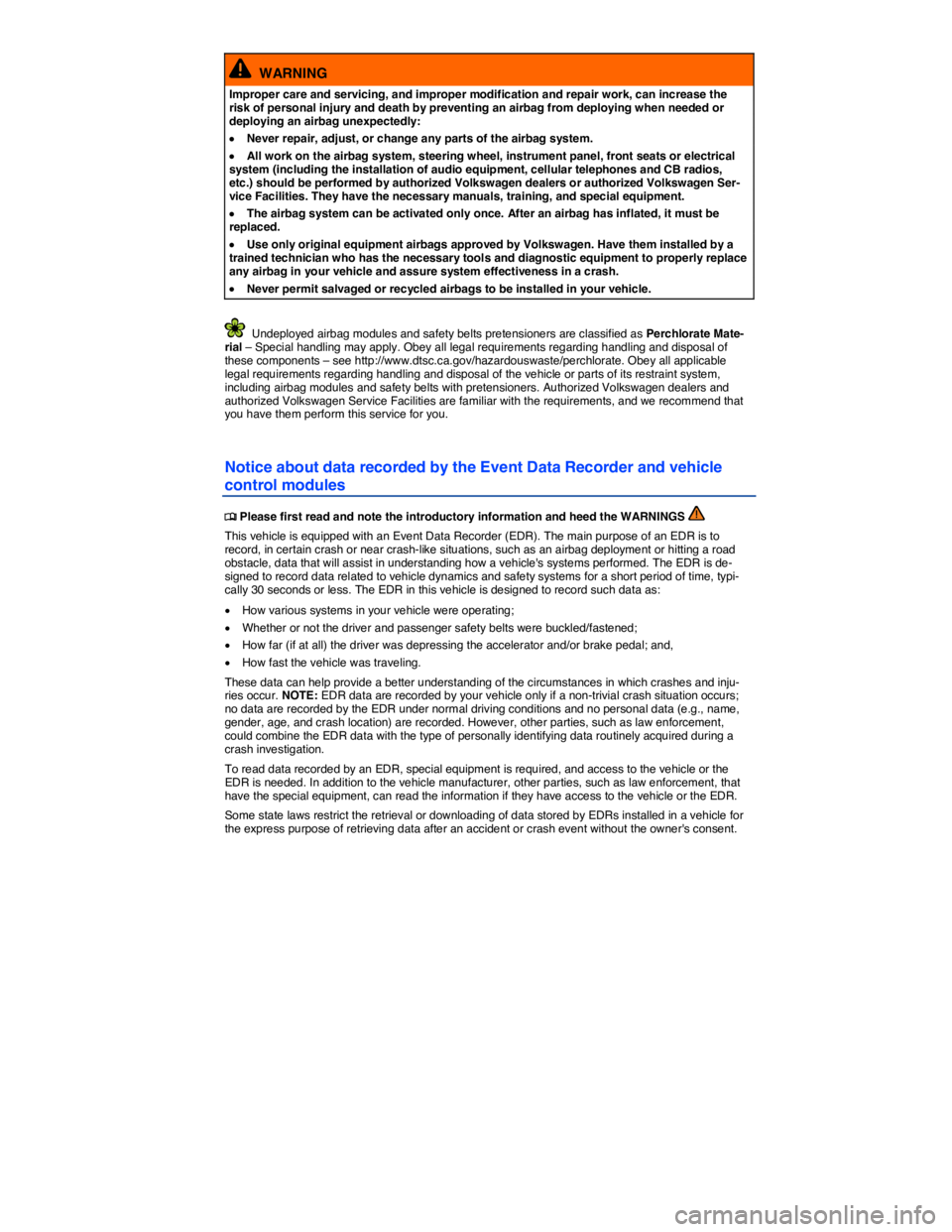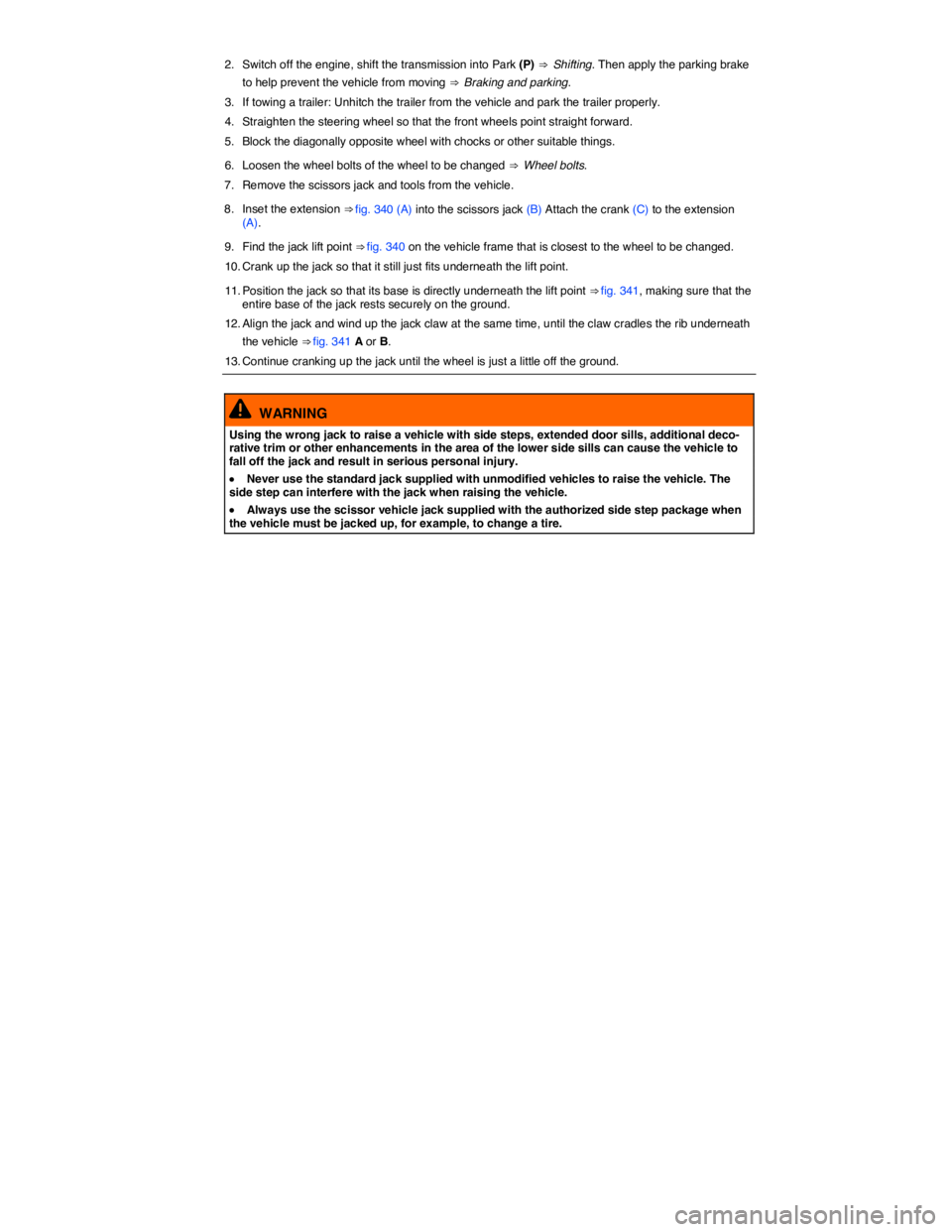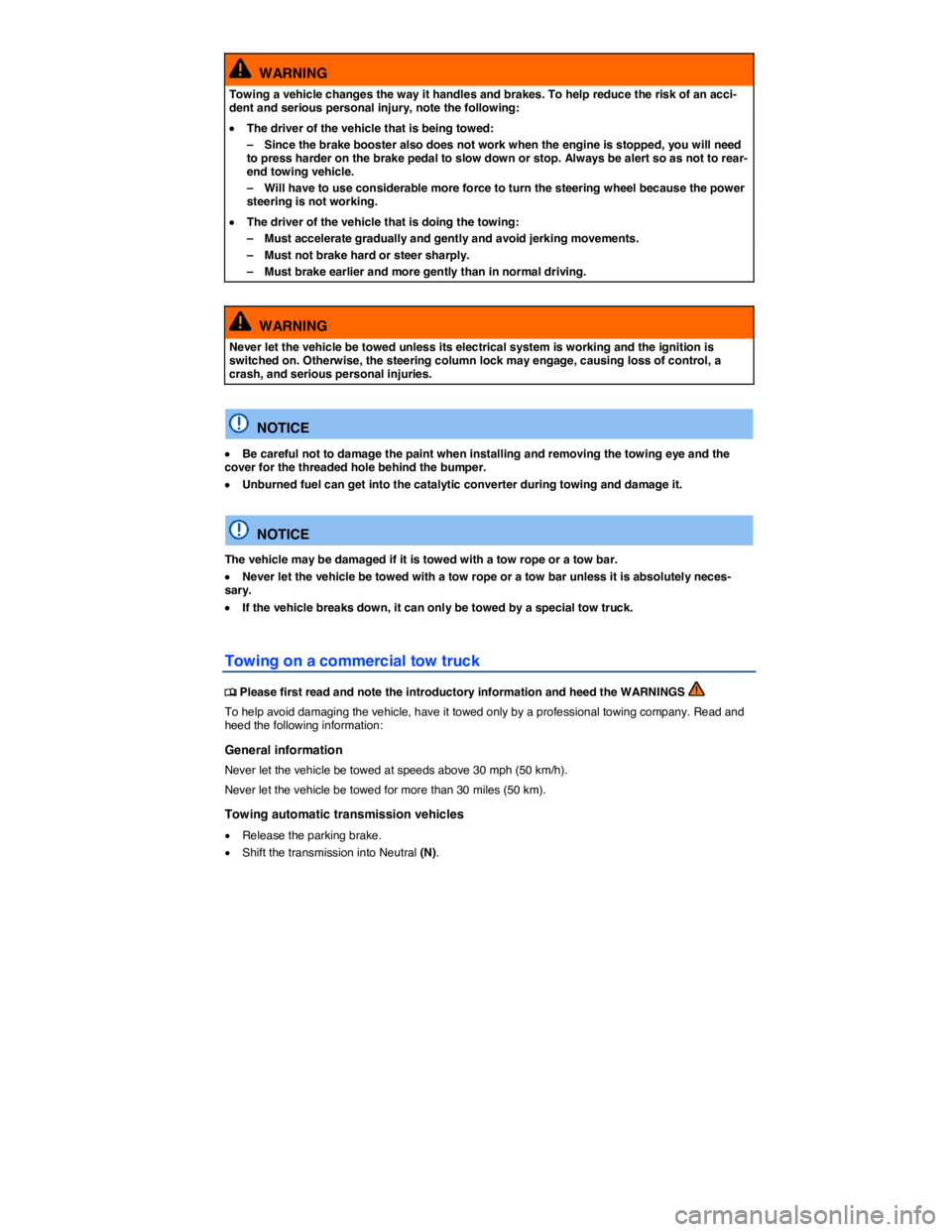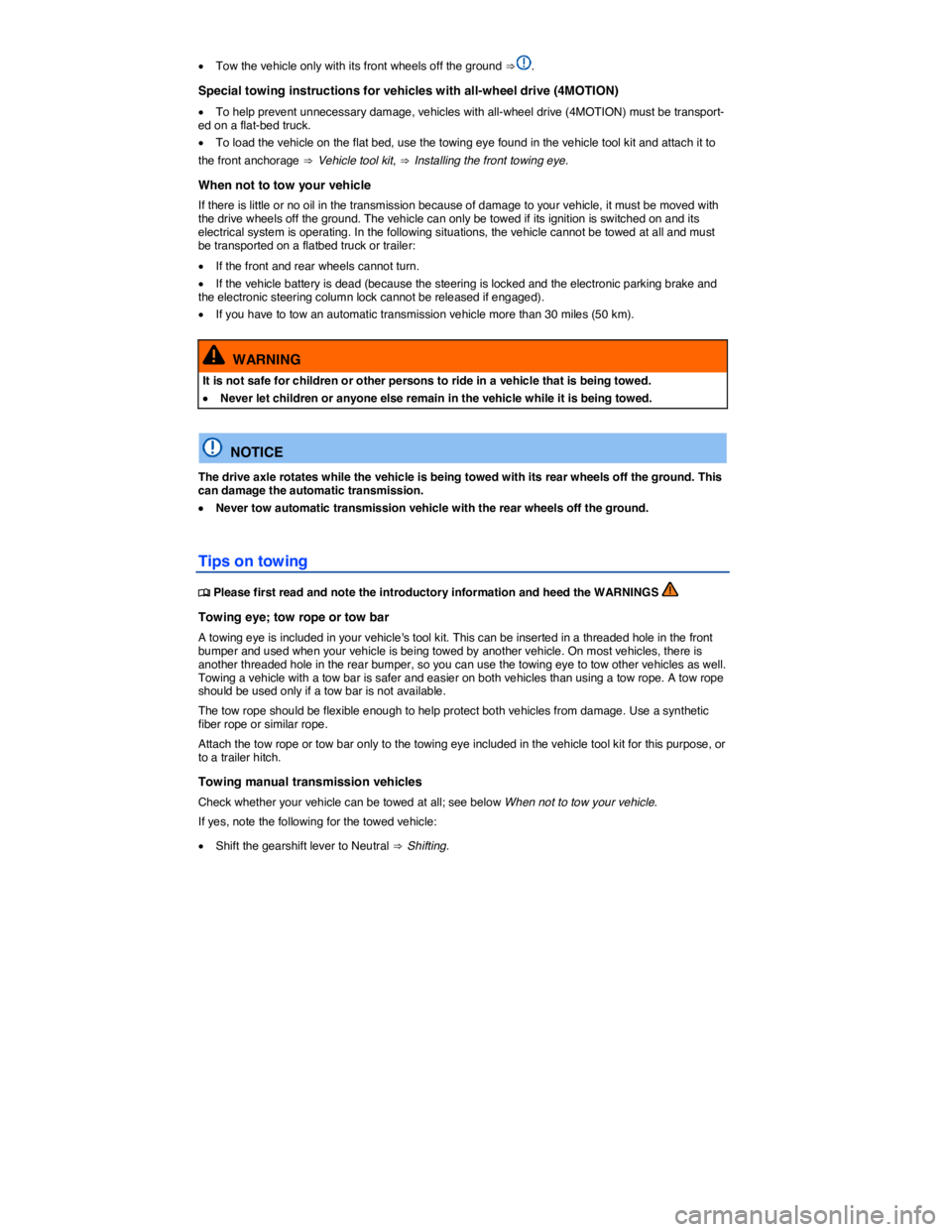2011 VOLKSWAGEN TOUAREG steering
[x] Cancel search: steeringPage 616 of 684

WARNING
Improper care and servicing, and improper modification and repair work, can increase the risk of personal injury and death by preventing an airbag from deploying when needed or deploying an airbag unexpectedly:
�x Never repair, adjust, or change any parts of the airbag system.
�x All work on the airbag system, steering wheel, instrument panel, front seats or electrical system (including the installation of audio equipment, cellular telephones and CB radios, etc.) should be performed by authorized Volkswagen dealers or authorized Volkswagen Ser-vice Facilities. They have the necessary manuals, training, and special equipment.
�x The airbag system can be activated only once. After an airbag has inflated, it must be replaced.
�x Use only original equipment airbags approved by Volkswagen. Have them installed by a trained technician who has the necessary tools and diagnostic equipment to properly replace any airbag in your vehicle and assure system effectiveness in a crash.
�x Never permit salvaged or recycled airbags to be installed in your vehicle.
Undeployed airbag modules and safety belts pretensioners are classified as Perchlorate Mate-rial – Special handling may apply. Obey all legal requirements regarding handling and disposal of these components – see http://www.dtsc.ca.gov/hazardouswaste/perchlorate. Obey all applicable legal requirements regarding handling and disposal of the vehicle or parts of its restraint system, including airbag modules and safety belts with pretensioners. Authorized Volkswagen dealers and authorized Volkswagen Service Facilities are familiar with the requirements, and we recommend that you have them perform this service for you.
Notice about data recorded by the Event Data Recorder and vehicle
control modules
�
Page 618 of 684

Therefore we strongly recommend that you use your cellular telephone in your vehicle only when it is properly attached to an appropriate cradle mounted on a base plate on the instrument panel.
Because of the large number and variety of cellular telephones on the market and the frequency with which new models are introduced, Volkswagen does not offer cradles for cellular telephones. Please check with the manufacturer of the cellular telephone that you plan to use.
WARNING
A mobile phone on the seat, instrument panel or in other places can be thrown around the inside of the vehicle during a sudden braking maneuver, a crash or other accident and injure vehicle occupants.
�x Never place or attach accessories or other objects (such as cup holders, telephone brack-ets, note pads, navigation systems, large, heavy or bulky objects) on the doors, on the wind-shield, over or near the area marked “AIRBAG” on the steering wheel, instrument panel, backrests or between these areas and the occupant. Such objects could cause serious injury in a collision, especially if an airbag inflates.
WARNING
Using a mobile phone or CB radio inside the vehicle without a properly installed and separate outside antenna can be dangerous to your health and that of your passengers because the electromagnetic radiation energy that mobile phones and CB radios emit may be above es-tablished limits. This also applies if the outside antenna is not installed properly.
�x Always keep the mobile phone antenna at least 8 inches (20 cm) away from pacemakers. Heart specialists advise that mobile phones can adversely affect the way of pacemakers work.
�x Never carry a mobile phone that is switched on in the breast pocket directly over the pacemaker.
�x If you suspect there may be interference with a pacemaker or other medical device, switch the mobile phone off immediately.
Page 658 of 684

2. Switch off the engine, shift the transmission into Park (P) ⇒ Shifting. Then apply the parking brake
to help prevent the vehicle from moving ⇒ Braking and parking.
3. If towing a trailer: Unhitch the trailer from the vehicle and park the trailer properly.
4. Straighten the steering wheel so that the front wheels point straight forward.
5. Block the diagonally opposite wheel with chocks or other suitable things.
6. Loosen the wheel bolts of the wheel to be changed ⇒ Wheel bolts.
7. Remove the scissors jack and tools from the vehicle.
8. Inset the extension ⇒ fig. 340 (A) into the scissors jack (B) Attach the crank (C) to the extension (A).
9. Find the jack lift point ⇒ fig. 340 on the vehicle frame that is closest to the wheel to be changed.
10. Crank up the jack so that it still just fits underneath the lift point.
11. Position the jack so that its base is directly underneath the lift point ⇒ fig. 341, making sure that the entire base of the jack rests securely on the ground.
12. Align the jack and wind up the jack claw at the same time, until the claw cradles the rib underneath
the vehicle ⇒ fig. 341 A or B.
13. Continue cranking up the jack until the wheel is just a little off the ground.
WARNING
Using the wrong jack to raise a vehicle with side steps, extended door sills, additional deco-rative trim or other enhancements in the area of the lower side sills can cause the vehicle to fall off the jack and result in serious personal injury.
�x Never use the standard jack supplied with unmodified vehicles to raise the vehicle. The side step can interfere with the jack when raising the vehicle.
�x Always use the scissor vehicle jack supplied with the authorized side step package when the vehicle must be jacked up, for example, to change a tire.
Page 676 of 684

WARNING
Towing a vehicle changes the way it handles and brakes. To help reduce the risk of an acci-dent and serious personal injury, note the following:
�x The driver of the vehicle that is being towed:
– Since the brake booster also does not work when the engine is stopped, you will need to press harder on the brake pedal to slow down or stop. Always be alert so as not to rear-end towing vehicle.
– Will have to use considerable more force to turn the steering wheel because the power steering is not working.
�x The driver of the vehicle that is doing the towing:
– Must accelerate gradually and gently and avoid jerking movements.
– Must not brake hard or steer sharply.
– Must brake earlier and more gently than in normal driving.
WARNING
Never let the vehicle be towed unless its electrical system is working and the ignition is switched on. Otherwise, the steering column lock may engage, causing loss of control, a crash, and serious personal injuries.
NOTICE
�x Be careful not to damage the paint when installing and removing the towing eye and the cover for the threaded hole behind the bumper.
�x Unburned fuel can get into the catalytic converter during towing and damage it.
NOTICE
The vehicle may be damaged if it is towed with a tow rope or a tow bar.
�x Never let the vehicle be towed with a tow rope or a tow bar unless it is absolutely neces-sary.
�x If the vehicle breaks down, it can only be towed by a special tow truck.
Towing on a commercial tow truck
�
Page 677 of 684

�x Tow the vehicle only with its front wheels off the ground ⇒ .
Special towing instructions for vehicles with all-wheel drive (4MOTION)
�x To help prevent unnecessary damage, vehicles with all-wheel drive (4MOTION) must be transport-ed on a flat-bed truck.
�x To load the vehicle on the flat bed, use the towing eye found in the vehicle tool kit and attach it to
the front anchorage ⇒ Vehicle tool kit, ⇒ Installing the front towing eye.
When not to tow your vehicle
If there is little or no oil in the transmission because of damage to your vehicle, it must be moved with the drive wheels off the ground. The vehicle can only be towed if its ignition is switched on and its electrical system is operating. In the following situations, the vehicle cannot be towed at all and must be transported on a flatbed truck or trailer:
�x If the front and rear wheels cannot turn.
�x If the vehicle battery is dead (because the steering is locked and the electronic parking brake and the electronic steering column lock cannot be released if engaged).
�x If you have to tow an automatic transmission vehicle more than 30 miles (50 km).
WARNING
It is not safe for children or other persons to ride in a vehicle that is being towed.
�x Never let children or anyone else remain in the vehicle while it is being towed.
NOTICE
The drive axle rotates while the vehicle is being towed with its rear wheels off the ground. This can damage the automatic transmission.
�x Never tow automatic transmission vehicle with the rear wheels off the ground.
Tips on towing
�
Page 678 of 684

�x Do not tow faster than 30 mph (50 km/h).
�x Do not tow more than 30 miles (50 km).
Towing automatic transmission vehicles
Check whether your vehicle can be towed at all; see below When not to tow your vehicle.
If yes, note the following for the towed vehicle:
�x Put the transmission in Neutral (N).
�x Do not tow faster than 30 mph (50 km/h).
�x Do not tow more than 30 miles (50 km).
�x When a commercial tow truck is being used, the vehicle must only be towed with the front wheels lifted off the ground.
�x Follow the special instructions for towing vehicles with all-wheel drive (4MOTION).
Towing vehicles with all-wheel drive (4MOTION)
Vehicles with all-wheel drive (4MOTION) should be towed with a tow bar or a tow rope. If the vehicle is towed with the front or rear axles lifted off the ground, the engine must be switched off. Otherwise the powertrain may be damaged.
When not to tow your vehicle
In the following situations, the vehicle cannot be towed and must be transported on a flatbed truck or trailer:
�x If transmission fluid has leaked out of the transmission.
�x If there is little or no oil in the transmission because of damage to your vehicle, it must be moved with the drive wheels off the ground.
�x If the front and rear wheels cannot turn.
�x When the vehicle battery is dead, since the steering may remain disabled, and it may not be possi-ble to release the electronic steering column lock and the electronic parking brake.
�x If you have to tow an automatic transmission vehicle more than 30 miles (50 km).
Towing other vehicles
�x Obey all legal requirements.
�x Read and heed all towing information in the owner’s manual for the other vehicle.
A vehicle can be towed only if the electronic parking brake and the electronic steering column lock can be released. In case of a power loss or malfunctions of the electrical system, the engine may have to be jump-started in order to release the electronic parking brake and the electronic steering column lock.
Page 681 of 684

As driver of the towed vehicle:
�x If your vehicle is the one being towed, the ignition switch must be switched on to keep the steering wheel from locking. Also make sure that the turn signals, horn, windshield wipers, and windshield washers work properly.
�x Since power steering does not work when the engine is switched off, more effort is needed to steer the vehicle.
�x Since the brake booster also does not work when the engine is stopped, you will need to press harder on the brake pedal to slow down or stop. Do not hit the towing vehicle.
�x Read and heed the information and WARNINGS in the towing vehicle's owner's manual.
As driver of the towing vehicle
�x Drive especially carefully and accelerate gently. Avoid sudden driving maneuvers.
�x Brake earlier than usual and with light pedal pressure.
�x Read and heed the information and WARNINGS in the owner's manual of the vehicle being towed.